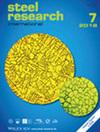Analysis of Rolling Force and Friction in Hot Steel Rolling with Water‐Based Nanolubrication
IF 1.9
3区 材料科学
Q2 METALLURGY & METALLURGICAL ENGINEERING
引用次数: 0
Abstract
Water‐based nanolubricants are playing increasingly important roles in hot steel rolling over the past decade regarding environmental protection, energy saving, and product quality improvement. The contact friction between the work roll and the workpiece under water‐based nanolubrication, however, has been scarcely investigated. In this study, water‐based lubricants containing 0–4.0 wt% TiO使用水基纳米润滑剂轧制热钢时的轧制力和摩擦力分析
近十年来,水基纳米润滑剂在热轧钢的环保、节能和产品质量改进方面发挥着越来越重要的作用。然而,关于水基纳米润滑剂下工作辊与工件之间的接触摩擦的研究却很少。本研究采用含 0-4.0 wt% TiO2 纳米颗粒的水基润滑剂,在不同轧制条件下对低碳钢进行热轧。采用田口方法对热轧试验进行正交设计,对影响轧制力的关键因素进行重要性排序。新合成的水基纳米润滑剂在静置 24 小时后显示出极佳的分散稳定性,并可通过手动振荡轻松恢复到原始状态。稳态热轧钢过程中的摩擦系数(COF)是通过热压试验开发的流动应力模型反向计算得出的。因此,通过多元线性回归,提出了一种新的钢材热轧 COF 模型。研究发现,线性回归结果与反演计算结果吻合良好,表明所提出的 COF 模型是适用的。最后,通过修改后的润滑油膜厚度模型确定的边界润滑机制研究了润滑机制。
本文章由计算机程序翻译,如有差异,请以英文原文为准。
求助全文
约1分钟内获得全文
求助全文
来源期刊

steel research international
工程技术-冶金工程
CiteScore
3.30
自引率
18.20%
发文量
319
审稿时长
1.9 months
期刊介绍:
steel research international is a journal providing a forum for the publication of high-quality manuscripts in areas ranging from process metallurgy and metal forming to materials engineering as well as process control and testing. The emphasis is on steel and on materials involved in steelmaking and the processing of steel, such as refractories and slags.
steel research international welcomes manuscripts describing basic scientific research as well as industrial research. The journal received a further increased, record-high Impact Factor of 1.522 (2018 Journal Impact Factor, Journal Citation Reports (Clarivate Analytics, 2019)).
The journal was formerly well known as "Archiv für das Eisenhüttenwesen" and "steel research"; with effect from January 1, 2006, the former "Scandinavian Journal of Metallurgy" merged with Steel Research International.
Hot Topics:
-Steels for Automotive Applications
-High-strength Steels
-Sustainable steelmaking
-Interstitially Alloyed Steels
-Electromagnetic Processing of Metals
-High Speed Forming
 求助内容:
求助内容: 应助结果提醒方式:
应助结果提醒方式:


